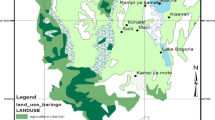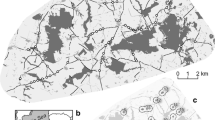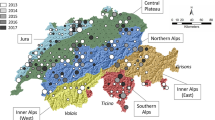Abstract
Genetic diversity and differentiation of two carabid beetle species were examined in woodlands along rural–urban gradients in two cities (Brussels, Belgium, and Birmingham, UK), based on allozymes, studied in more than 1000 beetles. Compared to Abax ater, Pterostichus madidus showed higher levels of genetic diversity but lower genetic differentiation, probably because of its ability to survive in non-forest habitats. Higher genetic diversity in both species was observed in Brussels as compared to Birmingham. However, genetic differentiation among sites was higher in Birmingham corresponding to the more extreme degree of fragmentation and isolation between the Birmingham woodlands. The isolation-by-distance model did not explain genetic differentiation among sites within the two regions. Gene diversity in P. madidus Birmingham populations was higher in smaller urban forests with a small perimeter. A similar absence of genetic erosion in smaller and more highly modified (urban) populations was also obtained for A. ater populations from Brussels, with a higher genetic diversity in sites closer to woodland edges. This unexpected result is hypothesised to be the result of an adaptive increase of genetic diversity in more heterogeneous landscapes, closer to woodland edges and in smaller and more perturbed forests.
Similar content being viewed by others
References
FW Allendorf RF Leary (1986) Heterozygosity and fitness in natural populations of animals ME Soulé (Eds) Conservation Biology: The Science of Scarcity and Diversity Sinauer Associates Sunderland, MA 57–76
MA Baars (1979) ArticleTitleCatches in pitfall traps in relation to mean densities of carabid beetles Oecologia 41 25–46
K Belkhir P Borsa L Chikhi N Raufaste F Bonhomme (1999) GENETIX 4.00, logiciel sous Windows TM pour la génétique des populations Université de Montpellier II Montpellier (France)
P Brandmayr T Zetto Brandmayr (1994) The evolutionary history of the genus Abax (Coleoptera Carabidae) K Desender M Dufrêne M Loreau ML Luff JP Maelfait (Eds) Carabid Beetles: Ecology and Evolution Kluwer Academic Publishers Dordrecht, Boston, London 19–24
V Castric L Bernatchez (2003) ArticleTitleThe rise and fall of isolation by distance in the anadromous brook charr (Salvelinus fontinalis Mitchill) Genetics 163 983–996
S Charrier S Petit F Burel (1997) ArticleTitleMovements of Abax parallelepipedus (Coleoptera, Carabidae) in woody habitats of a hedgerow network landscape: a radio-tracing study Agr. Ecosyst. Environ. 61 133–144
Desender K (in press) Theory versus reality: a review on the ecological and population genetic effects of forest fragmentation on wild organisms, with an emphasis on ground beetles. In: Carabidology 2003. Proceedings of the 11th European Carabidologists” Meeting (eds. Lovei GL, Toft S). Reports of the Danish Institute of Agricultural Sciences (DIAS Reports), Slagelse, Denmark.
K Desender Th Backeljau K Delahaye L Meester ParticleDe (1998) ArticleTitleAge and size of European saltmarshes and the population genetic consequences for ground beetles Oecologia 114 503–513
K Desender J Serrano (1999) ArticleTitleA genetic comparison of Atlantic and Mediterranean populations of a saltmarsh beetle Belg. J. Zool. 129 83–94
K Desender P Verdyck (2001) ArticleTitleGeographic scaling and genetic differentiation in two highly mobile European saltmarsh beetles Belg. J. Zool. 131 29–40
K Desender A Ervynck G Tack (1999) ArticleTitleBeetle diversity and historical ecology of woodlands in Flanders Belg. J. Zool. 129 139–156
Environmental Systems Research Institute (1992) ArcView Geographical Information System Version 3.2, Environmental Systems Research Institute, Copyright 1992–1999.
R Frankham (1995) ArticleTitleConservation genetics Annu. Rev. Genet. 29 305–327
J Goudet (1995) ArticleTitleFSTAT (vers. 1.2): A computer program to calculate F-statistics J. Hered. 86 485–486
E Halme J Niemelä (1993) ArticleTitleCarabid beetles in fragments of coniferous forest Ann. Zool. Fenn. 30 17–30
A Hastings S Harrison (1994) ArticleTitleMetapopulation dynamics and genetics Annu. Rev. Ecol. Syst. 25 167–188
PDN Hebert MJ Beaton (1989) Methodologies for Allozyme Analysis Using Cellulose Acetate Electrophoresis Helena Laboratories Beaumont
GM Hewitt (1999) ArticleTitlePost-glacial re-colonization of European biota Biol. J. Linn. Soc. 68 87–112
U Irmler (2001) ArticleTitleBedeutung urbaner Brachen für Laufkäfer (Carabidae) Faun-Ökol Mitt. 8 135–145
I Keller CR Largiader (2003a) ArticleTitleRecent habitat fragmentation caused by major roads leads to reduction of gene flow and loss of genetic variability in ground beetles Proc. R. Soc. Lond. B. 270 417–423
I Keller CR Largiader (2003b) ArticleTitleFive microsatellite DNA markers for the ground beetle Abax parallelepipedus (Coleoptera, Carabidae) Mol. Ecol. Notes. 3 113–114
HJ Mader (1984) ArticleTitleAnimal Habitat Isolation by Roads and Agricultural Fields Biol. Conserv. 29 81–96
T Magura V Kodobocz B Tothmeresz (2001) ArticleTitleEffects of habitat fragmentation on carabids in forest patches J. Biogeogr. 28 129–138
GK Meffe CR Carroll (1994) Principles of Conservation Biology. Sinauer Associates Sunderland MA
Miller MP (1997) Tools for Population Genetic Analysies (TFPGA) Version 1.3: A Windows Program for the Analysis of Allozyme and Molecular Population Genetic Data. Department of Biological Sciences, Northern Arizona University.
JB Mitton MC Grant (1984) ArticleTitleAssociations amoung protein heterozygosity, growth rate, and developmental homeostasis Annu. Rev. Ecol. Syst. 15 479–499
F-J Niehues P Hockmann F Weber (1996) ArticleTitleGenetics and dynamics of a Carabus auronitens metapopulation in the Westphalian Lowlands (Coleoptera, Carabidae) Ann. Zool. Fenn. 33 85–96
J Niemelä J Kotze A Ashworth P Brandmayr K Desender T New L Penev M Samways J Spence (2000) ArticleTitleThe search for common anthropogenic impacts on biodiversity: A global network J. Insect. Conserv. 4 3–9
J Niemelä (2001) ArticleTitleCarabid Beetles (Coleoptera : Carabidae) and Habitat Fragmentation: A Review Eur. J. Entomol. 98 127–132
RJ Petit I Aguinagalde JL Beaulieu Particlede C Bittkau S Brewer R Cheddadi R Ennos S Fineschi D Grivet M Lascoux A Mohanty GM MüllerStarck B DemesureMusch A Palme JP Martin S Rendell GG Vendramin (2003) ArticleTitleGlacial refugia: Hotspots but not melting pots of genetic diversity Science 300 1563–1565
S Petit F Burel (1998) ArticleTitleEffects of landscape dynamics on the metapopulation of a ground beetle (Coleoptera, Carabidae) in a hedgerow network Agric. Ecosyst. Environ. 69 243–252
RV Pouyat RW Parmelee MM Carreiro (1994) ArticleTitleEnvironmental effects of forest soil-invertebrate and faunal densities in oak stands along an urban–rural land-use gradient Pedobiologia 38 385–399
O Rackham (1988) Trees and woodland in a crowded landscape–the cultural landscape of the British Isles HH Birks HJB Birks PE Kaland D Moe (Eds) The cultural landscape–past present and future Cambridge University Press Cambridge 53–77
HJ Read MH Martin JMV Rayner (1998) ArticleTitleInvertebrates in woodlands polluted by heavy metals–An evaluation using canonical correspondence analysis Water Air Soil Pollut. 106 17–42
F Rousset M Raymond (1995) ArticleTitleTesting heterozygote excess and deficiency Genetics 140 1413–1419
EC Small (2002) Biodiversity and Population Persistence of Carabid Beetles (Coleoptera: Carabidae) in Fragmented Urban Habitats University of Birmingham Birmingham, UK
PW Stangel MR Lennartz MH Smith (1992) ArticleTitleGenetic variation and population structure of Red-cockaded Woodpeckers Conserv. Biol. 6 283–292
C Stauffer F Lakatos GM Hewitt (1999) ArticleTitlePhylogeography and postglacial colonization routes of Ips typographus L. (Coleoptera, Scolytidae) Mol. Ecol. 8 763–773
P Taberlet L Fumagalli AG Wustsaucy JF Cosson (1998) ArticleTitleComparative phylogeography and postglacial colonization routes in Europe Mol. Ecol. 7 453–464
T Tscharntke I Steffan-Dewenter A Kruess C Thies (2002) ArticleTitleCharacteristics of insect populations on habitat fragments: a mini review Ecol. Res. 17 229–239
MB Usher JP Field SE Bedford (1993) ArticleTitleBiogeography and diversity of ground-dwelling arthropods in farm woodlands Biodiv. Letters. 1 54–62
RD Ward DOF Skibinski M Woodwark (1992) Protein heterozygosity, protein structure and taxanomic differentiation MK Hecht B Wallace RJ MacIntyre (Eds) Evolutionary Biology Plenum Press New York 73–159
BS Weir CC Cockerham (1984) ArticleTitleEstimating F-statistics for the analysis of population structure Evolution 38 1358–1370
HR Wilcock AG Hildrew RA Nichols (2001) ArticleTitleGenetic differentiation of a European caddisfly: Past and present gene flow among fragmented larval habitats Mol. Ecol. 10 1821–1834
BC Wood AS Pullin (2002) ArticleTitlePersistence of species in a fragmented urban landscape: The importance of dispersal ability and habitat availability for grassland butterflies Biodiv. Conserv. 11 1451–1468
S Wright (1943) ArticleTitleIsolation by distance Genetics 28 114–138
A Young T Boyle T Brown (1996) ArticleTitleThe population genetic consequences of habitat fragmentation for plants TREE 11 413–418
Author information
Authors and Affiliations
Corresponding author
Rights and permissions
About this article
Cite this article
Desender, K., Small, E., Gaublomme, E. et al. Rural–urban gradients and the population genetic structure of woodland ground beetles. Conserv Genet 6, 51–62 (2005). https://doi.org/10.1007/s10592-004-7748-3
Received:
Accepted:
Issue Date:
DOI: https://doi.org/10.1007/s10592-004-7748-3




